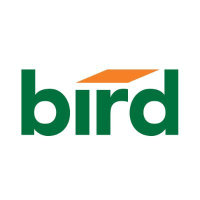
Bird Construction Inc
TSX:BDT


| US |

|
Johnson & Johnson
NYSE:JNJ
|
Pharmaceuticals
|
| US |

|
Berkshire Hathaway Inc
NYSE:BRK.A
|
Financial Services
|
| US |

|
Bank of America Corp
NYSE:BAC
|
Banking
|
| US |

|
Mastercard Inc
NYSE:MA
|
Technology
|
| US |

|
UnitedHealth Group Inc
NYSE:UNH
|
Health Care
|
| US |

|
Exxon Mobil Corp
NYSE:XOM
|
Energy
|
| US |

|
Pfizer Inc
NYSE:PFE
|
Pharmaceuticals
|
| US |

|
Palantir Technologies Inc
NYSE:PLTR
|
Technology
|
| US |

|
Nike Inc
NYSE:NKE
|
Textiles, Apparel & Luxury Goods
|
| US |

|
Visa Inc
NYSE:V
|
Technology
|
| CN |

|
Alibaba Group Holding Ltd
NYSE:BABA
|
Retail
|
| US |

|
3M Co
NYSE:MMM
|
Industrial Conglomerates
|
| US |

|
JPMorgan Chase & Co
NYSE:JPM
|
Banking
|
| US |

|
Coca-Cola Co
NYSE:KO
|
Beverages
|
| US |

|
Walmart Inc
NYSE:WMT
|
Retail
|
| US |

|
Verizon Communications Inc
NYSE:VZ
|
Telecommunication
|
Utilize notes to systematically review your investment decisions. By reflecting on past outcomes, you can discern effective strategies and identify those that underperformed. This continuous feedback loop enables you to adapt and refine your approach, optimizing for future success.
Each note serves as a learning point, offering insights into your decision-making processes. Over time, you'll accumulate a personalized database of knowledge, enhancing your ability to make informed decisions quickly and effectively.
With a comprehensive record of your investment history at your fingertips, you can compare current opportunities against past experiences. This not only bolsters your confidence but also ensures that each decision is grounded in a well-documented rationale.
Do you really want to delete this note?
This action cannot be undone.

| 52 Week Range |
13.2835
32.55
|
| Price Target |
|
We'll email you a reminder when the closing price reaches CAD.
Choose the stock you wish to monitor with a price alert.

|
Johnson & Johnson
NYSE:JNJ
|
US |

|
Berkshire Hathaway Inc
NYSE:BRK.A
|
US |

|
Bank of America Corp
NYSE:BAC
|
US |

|
Mastercard Inc
NYSE:MA
|
US |

|
UnitedHealth Group Inc
NYSE:UNH
|
US |

|
Exxon Mobil Corp
NYSE:XOM
|
US |

|
Pfizer Inc
NYSE:PFE
|
US |

|
Palantir Technologies Inc
NYSE:PLTR
|
US |

|
Nike Inc
NYSE:NKE
|
US |

|
Visa Inc
NYSE:V
|
US |

|
Alibaba Group Holding Ltd
NYSE:BABA
|
CN |

|
3M Co
NYSE:MMM
|
US |

|
JPMorgan Chase & Co
NYSE:JPM
|
US |

|
Coca-Cola Co
NYSE:KO
|
US |

|
Walmart Inc
NYSE:WMT
|
US |

|
Verizon Communications Inc
NYSE:VZ
|
US |
This alert will be permanently deleted.
 Bird Construction Inc
Bird Construction Inc
Bird Construction Inc
Investor Relations
Bird Construction, Inc. is an investment holding company with interest in construction services. The company is headquartered in Etobicoke, Ontario. The company went IPO on 2006-02-22. The firm focuses primarily on projects in the industrial, commercial and institutional sectors of the general contracting industry. In the industrial sector, it constructs industrial buildings, including manufacturing, processing, distribution, and warehouse facilities, and performs civil construction operations, including site preparation, concrete foundations, metal and modular fabrication, mechanical process work, underground piping and earthwork. In the commercial sector, its operations include construction and renovation of office buildings, shopping malls and plazas, big box stores and grocery stores and hotels for retailers and developers. In the institutional sector, it constructs and renovates hospitals, post-secondary education facilities, recreation facilities, prisons, courthouses, government buildings, long term care and senior housing, as well as environmental facilities and many others.

Bird Construction, Inc. is an investment holding company with interest in construction services. The company is headquartered in Etobicoke, Ontario. The company went IPO on 2006-02-22. The firm focuses primarily on projects in the industrial, commercial and institutional sectors of the general contracting industry. In the industrial sector, it constructs industrial buildings, including manufacturing, processing, distribution, and warehouse facilities, and performs civil construction operations, including site preparation, concrete foundations, metal and modular fabrication, mechanical process work, underground piping and earthwork. In the commercial sector, its operations include construction and renovation of office buildings, shopping malls and plazas, big box stores and grocery stores and hotels for retailers and developers. In the institutional sector, it constructs and renovates hospitals, post-secondary education facilities, recreation facilities, prisons, courthouses, government buildings, long term care and senior housing, as well as environmental facilities and many others.





























 You don't have any saved screeners yet
You don't have any saved screeners yet
